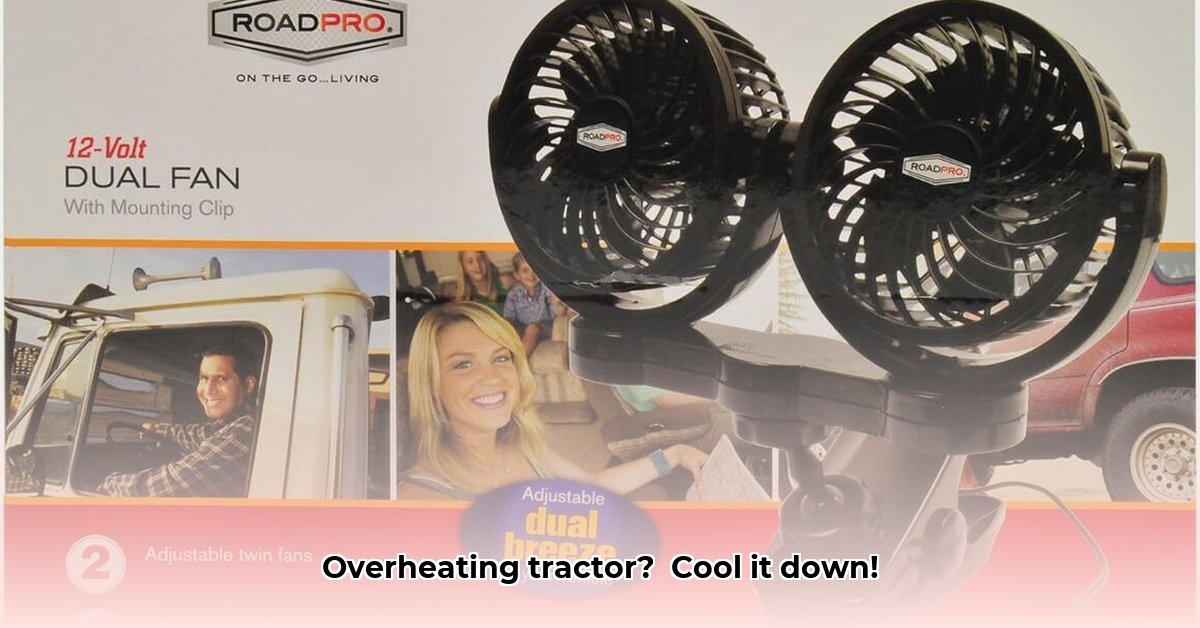
Understanding the Need for Efficient Tractor Cooling
Ever felt your tractor straining under the summer sun? Overheating isn't just uncomfortable; it's a major drain on fuel efficiency, engine lifespan, and your bottom line. Costly repairs, frustrating downtime, and reduced yields are all consequences of inadequate cooling. This is where 12-volt fans step in as unsung heroes, ensuring your tractor runs smoothly even in the most challenging conditions. But choosing the right fan is crucial. For added comfort, consider a tractor cab heater. This guide will equip you with the knowledge to select, install, and maintain a 12-volt fan, maximizing your tractor's performance and contributing to more sustainable farming practices. Did you know that improved cooling can lead to a significant reduction in fuel consumption, thus decreasing your environmental impact?
Choosing the Right 12-Volt Fan: Axial vs. Centrifugal
Selecting the perfect 12-volt fan requires understanding your tractor's specific needs. Two main types dominate the market: axial and centrifugal. Axial fans, like propellers, push air directly forward. They are generally simpler, lighter, and more affordable, ideal for general cooling needs. Centrifugal fans, however, operate like miniature turbines, forcing air outwards – excellent for situations where air needs to navigate dense radiators or other challenging spaces.
Several key factors determine the ideal fan:
- Engine Size: Larger engines generate more heat, demanding more powerful fans (higher CFM – cubic feet per minute).
- Radiator Size and Design: A larger radiator often needs a higher airflow fan.
- Mounting Space: Measure your available space carefully before purchasing.
- Airflow (CFM): Higher CFM equates to better cooling.
- Static Pressure: This measures the fan's ability to overcome resistance. High static pressure is vital for systems with restricted airflow.
Let's compare these fan types in a concise table:
| Fan Type | CFM Range | Static Pressure | Advantages | Disadvantages |
|---|---|---|---|---|
| Axial | 1000-5000 CFM | Low | Simple, affordable, lightweight | Lower static pressure, less efficient in restricted spaces |
| Centrifugal | 500-3000 CFM | High | Higher static pressure, suitable for dense radiators | More complex, heavier, generally more expensive |
Remember, these are broad ranges. Always consult the manufacturer's specifications for precise ratings. A properly chosen fan prevents costly overheating issues and improves overall engine performance.
Installation Guide: A Step-by-Step Approach
Installing a 12-volt fan is a manageable task, but safety is paramount.
Step 1: Safety First! Disconnect the tractor's battery negative terminal. This precaution prevents electrical shocks and short circuits.
Step 2: Gather Supplies: Assemble the necessary tools (screwdrivers, wrenches, potentially a multimeter), your new fan, and your tractor's manual.
Step 3: Old Fan Removal (if applicable): Carefully remove the old fan, noting its wiring and mounting. Photographs can be invaluable.
Step 4: Mounting the New Fan: Securely fasten the new fan, ensuring correct alignment and ample clearance for blade rotation.
Step 5: Wiring: Connect the fan wires to the appropriate terminals, referencing your tractor's manual and the fan's instructions. A multimeter can verify correct voltage.
Step 6: Testing: Reconnect the battery, start the tractor, and verify the fan's operation and engine temperature. Is the engine running cooler than before?
Troubleshooting: If problems arise, double-check wiring, fan rotation, and airflow. Inefficient airflow significantly impacts cooling even with a new fan.
Cost-Benefit Analysis and Sustainability
Investing in efficient cooling offers substantial long-term benefits. Reduced downtime translates directly to increased productivity. Improved fuel efficiency lowers operation costs. The extended engine lifespan minimizes costly replacements. These factors combine to create a strong return on investment. Furthermore, reduced fuel consumption contributes to environmentally sustainable farming practices. Isn't this worth the investment?
Future Trends in Tractor Cooling
The industry continues to innovate. We can expect more sophisticated cooling systems incorporating sensor technology and automated control, leading to “smart” systems offering precise temperature management and optimized fuel efficiency. This trend emphasizes the importance of adopting advanced cooling solutions today, as they pave the way for a more environment-friendly agricultural industry. Dr. Anya Sharma, Agricultural Engineering Professor at Cornell University, notes, "The integration of smart cooling systems with tractor management systems is inevitable, leading to predictive maintenance and reduced downtime."
Key Takeaways:
- Efficient cooling directly impacts fuel economy, engine longevity, and overall productivity.
- Careful fan selection, based on your tractor's specifications, is paramount.
- Proper installation and regular maintenance prevent costly repairs and downtime.
- Investing in superior cooling contributes to both financial profitability and environmental sustainability. The cost savings alone are considerable.